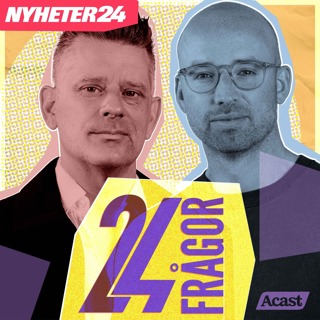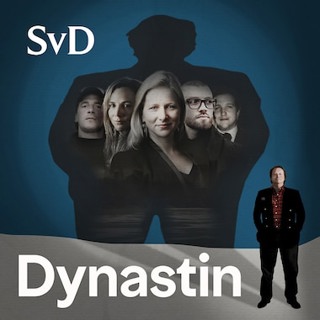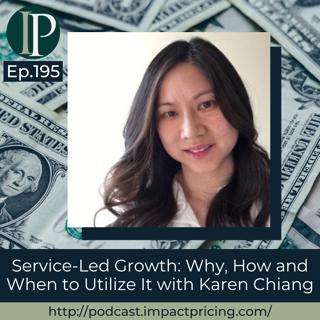
Service-Led Growth: Why, How and When to Utilize It with Karen Chiang
Karen Chiang is a co-founder and managing partner of Ibbaka, a company that provides software and expertise to enable business growth by optimizing revenue performance through customer value management and talent optimization. In this episode, Karen talks about service-led growth and its advantages over product-led growth in certain situations. She also tells us when and how to utilize it, along with the concept of collaborating with the customer throughout the journey in order to maintain and maximize the value of your product or services. Why you have to check out today’s podcast: Learn the fundamentals of service-led growth Discover why service-led growth might be more useful to your business than product-led growth Find out how to maintain and maximize value by keeping in touch with your clients “My piece of advice is for any business to recognize the importance that pricing can play in reaching their growth targets and objectives and making sure that they recognize that pricing has to be rooted in value” – Karen Chiang Topics Covered: 01:12 – How Karen got into pricing 01:53 – What is service-led growth? 04:09 – Product-led growth vs. service-led growth: Which one to use, and when 14:47 – Is service-led growth functional in industries other than consulting? 18:26 – How knowing the insights of your customers helps in increasing the value for your product 21:02 – The concept of customer journey in service-led growth 23:52 – The difference between product-led growth and service-led growth 26:54 – Karen’s pricing advice 28:24 – Connect with Karen Chiang Key Takeaways: “The reality is that not all customers are looking for product-led solutions.” – Karen Chiang “If you are working with customers which are trying to solve complex problems, which require a more collaborative approach, then you are not in the business of product-led growth or you shouldn't choose product-led growth as your strategy. In fact, you should be looking at service-led growth.” – Karen Chiang “Pricing is very linked, very much linked to the value that your customer cares about.” – Karen Chiang “With service-led growth, you are not just thinking about the term of the platform once a year. You are, by nature, collaborating with your customer throughout the journey.” – Karen Chiang People / Resources Mentioned: Ibbaka: https://www.ibbaka.com/ Steven Forth: https://www.linkedin.com/in/stevenforth Connect with Karen Chiang: LinkedIn: https://www.linkedin.com/in/karen-chiang-2623241/ Email: karen@ibbaka.com Connect with Mark Stiving: LinkedIn: https://www.linkedin.com/in/stiving/ Email: mailto:mark@impactpricing.com
24 Okt 202229min

Blogcast #77: How to Give Salespeople Discount Authority
This is an Impact Pricing Blog published on September 14, 2022, turned into an audio podcast so you can listen on the go. Read Full Article Here: https://impactpricing.com/blog/how-to-give-salespeople-discount-authority/ If you have any feedback, definitely send it. You can reach us at mark@impactpricing.com. Now, go make an impact. Connect with Mark Stiving: Email: mark@impactpricing.com LinkedIn: https://www.linkedin.com/in/stiving/
21 Okt 20223min
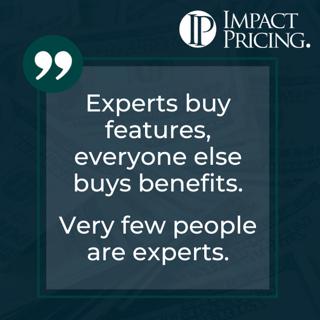
Memecast #80: Queen of Spades: Experts Buy Features, Everyone Else Buys Benefits
This one is the Queen of Spades from the Selling Value card deck. It turns out that when we shop for something, especially if it's something that we've never owned before, we've never purchased before, we are not experts in the product. We're trying to learn as much as we can about what makes sense. What's going to be good for us. Where's the best bang for our buck. We are not experts in the product category. And yet, if it's something that we've bought many, many times, as we become expert, then we stop thinking about what are the benefits I need to achieve and we start thinking about what are the features. Possibly my favorite example of this is imagine buying a computer. I'm guessing you've bought many computers in your life and you understand what many of the features do for you. For example, the size of the hard disc or the size of the RAM. And when you walk into a Best Buy store and you're going to buy a new computer, when the geek says to you, "Yeah, this one does emails and photos really well." You're thinking, "Go away, I don't want to know the benefits. Tell me what's the size of the hard disc, how much RAM, where's the processor speed." On the other hand, imagine it was your first computer. And someone walks in and says, "This is a two-gigabit processor with quad processors and two terabytes of hard disc and 256 gigabytes of memory." And you're thinking, "Is that good or not?" Because then you need the benefits. Most of the time, if we've got a direct salesperson selling a product, we're selling to somebody who hasn't bought the product before. We're selling to somebody who isn't an expert. And what that means is we should stop talking about our features, we really need to talk about our benefits. Features are simply proof points that we can achieve the benefits. We hope you enjoyed this memecast. This is also an example of how Pricing Table Topics works. Grab a deck of our cards, pull out a random card, read the saying, and then talk for one to two minutes about what that card says. This will improve your understanding and more importantly, your ability to communicate important concepts about value. If you have any questions or feedback, please email me mark@impactpricing.com. Now, go make an impact. Connect with Mark Stiving: Email: mark@impactpricing.com LinkedIn: https://www.linkedin.com/in/stiving/
19 Okt 20222min
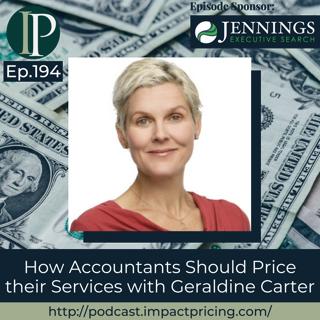
How Accountants Should Price their Services with Geraldine Carter
Geraldine Carter runs She Thinks Big Coaching where she helps CPAs do less without sacrificing revenue. Although her target market are CPAs, she actually has a bachelor’s degree in civil engineering from Cornell University. She was also a cycling guide for Backroads and now hosts her own podcast called The Business Strategy for CPAs. In this episode, she talks about the structure of pricing in the accounting industry and the reason why most CPAs are underpriced. She then discusses her so-called “effortless value” where accountants could earn more without having to do extra work. Finally, she shares her tips on how accountants could earn more by having expertise and charging their clients more. Why you have to check out today’s podcast: Learn why you should have a deep expertise instead of being a generalist Acquire techniques on how to increase your value without doing more Discover the reason why charging more is better for you and your clients “It’s good for your clients to charge them more” – Geraldine Carter Topics Covered: 01:33 – How Geraldine got into pricing 03:10 – The problem of pricing in the accounting industry 05:24 – What is Menu Pricing and its difference from Subscription Pricing 09:16 – CPAs are not a subscription 10:11 – How “billing” works in CPAs 11:56 – The prevailing mindset among CPAs 13:11 – Why having a deep expertise is essential in getting better prices 17:04 – The mindset that needs to be changed in the accounting industry 17:54 – What is “Effortless Value” 20:49 – Geraldine’s bicycling pricing story 24:06 – Pricing table topics: Subscriptions have three revenue buckets: win, keep, and grow. Manage all three. 27:51: Geraldine’s pricing advice Key Takeaways: “You can legitimately be given the marketplace and the absence of segmentation, become an expert and have expertise that the client cannot find anywhere else, either in their zip code or on the Internet. It just doesn't exist. There's so little competition that if you in fact do have deep expertise." – Geraldine Carter “Effortless value is this idea of going through your business and looking at all the ways you could improve. You could add value to your clients experience without it being more work.” – Geraldine Carter “Your buyers take your price as a signal of quality. And if it is not high enough for what they are expecting to pay, they will keep on walking.” – Geraldine Carter “If your delivery is dialed in and your clients are delighted and you make good on your promise, they will continue to stay.” – Geraldine Carter People / Resources Mentioned: She Thinks Big Coaching: https://geraldinecarter.com/ Smart Strategy for CPAs: https://www.businessstrategyforcpas.com/ Jonathan Stark: https://jonathanstark.com/ Ron Baker: https://www.linkedin.com/in/ronbaker1/ Selling Value: How to Win More Deals in Higher Prices: https://www.amazon.com/Selling-Value-Deals-Higher-Prices/dp/1737655217 Connect with Geraldine Carter: LinkedIn: https://www.linkedin.com/in/geraldine-carter/ Email: gc@geraldinecarter.com Website: https://geraldinecarter.com/ Connect with Mark Stiving: LinkedIn: https://www.linkedin.com/in/stiving/ Email: mailto:mark@impactpricing.com
17 Okt 202229min
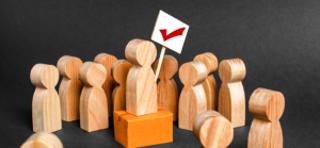
Blogcast #76: Why You SHOULD Give Salespeople Discount Authority
This is an Impact Pricing Blog published on September 7, 2022, turned into an audio podcast so you can listen on the go. Read Full Article Here: https://impactpricing.com/blog/why-you-should-give-salespeople-discount-authority/ If you have any feedback, definitely send it. You can reach us at mark@impactpricing.com. Now, go make an impact. Connect with Mark Stiving: Email: mark@impactpricing.com LinkedIn: https://www.linkedin.com/in/stiving/
14 Okt 20222min
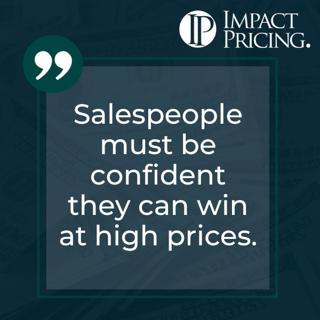
Memecast #79: King of Diamonds: Salespeople Must Be Confident They Can Win at High Prices
This one is the King of Diamonds from the Selling Value card deck. If a salesperson doesn't believe they're going to win selling your product, they're not going to try to sell your product. They don't want to bang their head against a wall. They're going to go sell whatever happens to be easiest. But the next step is, assuming they can sell our product, how do we get them to sell it and win at the higher prices to stop giving away deep discounts? Well, the question becomes, does a salesperson truly believe your product is worth the price? If a salesperson has confidence that their customer is going to get so much more value than whatever the price is that we're going to charge, then they're much more likely to win at higher prices. If a salesperson questions the amount of value customers might get, if a salesperson doesn't believe deep down in their soul that this product is a great product for their customer, then they're going to tend to discount. They're going to offer discounts and hope that the buyer says, “Yes, finally, the value that I receive is worth the price that you're asking.” What we want is for our salespeople to go in confidently. What we really want is for our salespeople to understand the value that we deliver, truly believe the value we deliver, and be able to communicate that value to the buyer. We hope you enjoyed this memecast. This is also an example of how Pricing Table Topics works. Grab a deck of our cards, pull a random card, read the saying, and then talk for one to two minutes about what that card says. This will improve your understanding and more importantly, your ability to communicate important concepts about value. If you have any questions or feedback, please email me mark@impactpricing.com. Now, go make an impact. Connect with Mark Stiving: Email: mark@impactpricing.com LinkedIn: https://www.linkedin.com/in/stiving/
12 Okt 20222min
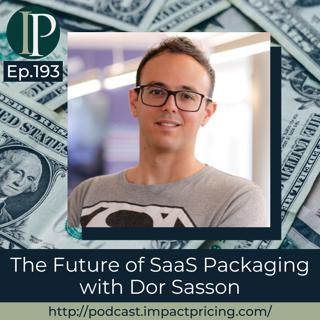
The Future of SaaS Packaging with Dor Sasson
Dor Sasson is the co-founder and CEO of Stigg, a company that helps clients grow with pricing through a software that enables them to control what can be priced and packaged separately, and make adjustments without having to do coding. He has also been a Senior Product Manager at New Relic, a technology company which develops cloud-based software to help website and application owners track the performance of their services. In this episode, Dor shares how his experience in New Relic led him to explore the field of SaaS packaging and how his company, Stigg, aims to provide solutions to packaging problems from the developers’ end. Why you have to check out today’s podcast: Pickup ideas about the adjustments to be done when switching to usage-based pricing Discover how Stigg could help you on your packaging and pricing problems Learn the importance of asking the right questions in the success of businesses “Talk to your customers, ask them about their willingness to pay. There are amazing frameworks out there for how to ask the right questions. It will unlock immense, deep understanding of how your customers think about your pricing and will really help you to nail down your own pricing strategy. – Dor Sasson Topics Covered: 01:11 – How Dor got into pricing 03:59 – What is “entitlements”? 04:52 – Adjustments made by New Relic upon switching to usage-based pricing 08:09 – The work that Stigg actually does 15:48 – The difference between buyers and users 16:35 – Situations in the past where Stigg would’ve been a big help 20:51 – Dor’s vision and mission for his company, Stigg 23:49 – Pricing table topics: “Good, better, best” pricing is significantly more effective within a market segment 26:38 – Dor’s pricing advice Key Takeaways: “The way we like to think about Stigg is, we want to build out an infrastructure that is so easy to implement and so easy to adopt from the application side that it makes it really fast and easy for product and growth teams to introduce new pricing plans, changes in existing pricing plans.” – Dor Sasson “The value that we unlock is for builders and growth leaders out there that are looking to use pricing as a vehicle for growth and help their companies continue to adapt to changing markets, continue to adapt to how they scale into new customer segments, and basically make sure that they give their buyers more options to use their software.” – Dor Sasson “Our North star by the end of the day is not only helping our customers be faster in the way they introduce changes and launch new pricing but also ultimately unlock growth by allowing more flexibility for their buyers to use and consume their products.” – Dor Sasson “There is no “one size fits all” in pricing. The first thing you got to do is understand in a very deep and thoughtful way, who are your customer segments, and good, better, best is actually a really good strategy to approach different customer segments and make sure that you build your pricing in a way that fits or is more aligned to the way each segment perceive value.” – Dor Sasson People / Resources Mentioned: Stigg: https://www.stigg.io/ New Relic: https://newrelic.com/ Connect with Dor Sasson: LinkedIn: https://www.linkedin.com/in/datapm/ Twitter: https://twitter.com/DorSasson Website: https://www.stigg.io/ Connect with Mark Stiving: LinkedIn: https://www.linkedin.com/in/stiving/ Email: mark@impactpricing.com
10 Okt 202229min

Blogcast #75: Why You Should NOT Give Salespeople Discount Authority
This is an Impact Pricing Blog published on August 31, 2022, turned into an audio podcast so you can listen on the go. Read Full Article Here: https://impactpricing.com/blog/why-you-should-not-give-salespeople-discount-authority/ If you have any feedback, definitely send it. You can reach us at mark@impactpricing.com. Now, go make an impact. Connect with Mark Stiving: Email: mark@impactpricing.com LinkedIn: https://www.linkedin.com/in/stiving/
7 Okt 20223min










